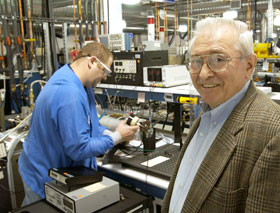  |
| HOME | THIS ISSUE | CALENDAR | GRANTS | BACK ISSUES | < BACK | NEXT > |
Engineering professor a pioneer in laser applications researchby Scott Brinckerhoff - January 23, 2006 |
||||
|
Goldfinger, the third James Bond film, introduced viewers to a fearsome new technology that threatened in one memorable scene to bisect Bond and deprive the world of the next 18 installments of 007’s adventures. The scene showed Bond immobilized on a steel table as a laser slowly vaporized the metal and made its way inexorably toward him. As it happens, Anthony DeMaria, one of UConn’s most illustrious alumni and an expert on lasers, was in London at a technical conference when Goldfinger hit the theaters and he went to see it. It’s a safe assumption that no one else in the audience that day in 1964 appreciated the laser scene quite the way DeMaria did. Now in his early 70s, DeMaria is a professor-in-residence at UConn’s Department of Electrical & Computer Engineering and chief scientist at Coherent-DEOS LLC, a laser manufacturer in Bloomfield. Retirement is not in his plans: “My work is my hobby and I like staying technically active,” he says. DeMaria is unusual not only for the depth of his knowledge of both lasers and photonics, but for the breadth of his careers in business, research, and academia. He holds 45 patents, has co-authored two books on lasers, and published 65 papers. He has taught at Rensselaer Polytechnic, UCLA, and elsewhere, and has been elected to both the National Academy of Sciences and the National Academy of Engineering, the only UConn alumnus to receive both of those honors. DeMaria received his undergraduate degree in electrical engineering from UConn in 1956 and his Ph.D., also from UConn, in 1965. He has since earned Distinguished Engineering and Alumni Awards. His laser research has united him with colleagues throughout the United States and around the world. “I was among the first American laser scientists to visit China in 1982 and the Soviet Union in 1967,” he recalls. “In China, we traveled 5,000 miles by trains, planes, boats, and buses.” He joined United Aircraft before it became United Technologies (UTC) and worked at Hamilton Standard (now Hamilton Sundstrand) and the United Technologies Research Center. “The corporation saw commercial possibilities for the CO2 laser, which had been invented recently at Bell Labs,” he says. “It showed promise in jet engine manufacturing for drilling precise holes for parts cooling and as a transmitter in laser radar applications.” Over the years, DeMaria has led or participated in pioneering research to find other laser/photonics applications within UTC’s product line. For Sikorsky Aircraft, his group evaluated lasers as a tool for alerting helicopter pilots to a common threat – high tension and other wires that can be difficult to see.
But it was some of his basic research that led to his election to the national academies and formed the basis for his Ph.D. thesis at UConn. That work involved the generation of extremely short laser pulses lasting a picosecond or less. A picosecond is the time it takes light to travel the thickness of a sheet of paper. At the time, these pulses were the shortest events ever generated by mankind and gave scientists new insight into the behavior of atoms and molecules. Laser devices are included within the field called “photonics,” which relates to the generation, amplification, detection, and propagation of “photons,” the smallest quantum of electro- magnetic energy. Lasers and related technologies may be highly complex, but they are also common, popping up everywhere in daily life. DeMaria notes that lasers are present in DVD players, pointers used in presentations, devices that read a computer disk, and bar code checkout systems in stores. They are also used in medicine, most notably in vision correction surgery, and in fiber optics telecommunication transmission systems. DeMaria left the United Technologies Research Center in 1994, after the corporation began focusing on core business that did not include lasers and photonics. He purchased the intellectual property of the CO2 laser unit at Hamilton and joined several colleagues to found DEOS – DeMaria Electro-Optics Systems Inc. The company took off, attracting the attention of Coherent, the world’s oldest and largest publicly traded laser company. Today Coherent employs about 240 people and ships thousands of CO2 lasers around the world. These lasers are small enough to sit on a desktop and range in price from a few thousand dollars up to about $400,000. They are sold for peaceful purposes to customers around the world. One Coherent laser is monitoring the upper atmosphere for NASA as part of a global warming study. DeMaria sold DEOS but stayed on as chief scientist, in keeping with his self-described addiction to lifelong learning. One day a week he comes to campus, to mentor students and faculty. “For students interested in either a research or an academic career, I advise them to go into a field they are passionate about,” he says. “It would be great if the field they are interested in is an emerging one, so that almost anything they work on will uncover new knowledge and make new discoveries. The field of photonics is certainly one to consider.” |
| ADVANCE HOME UCONN HOME |

